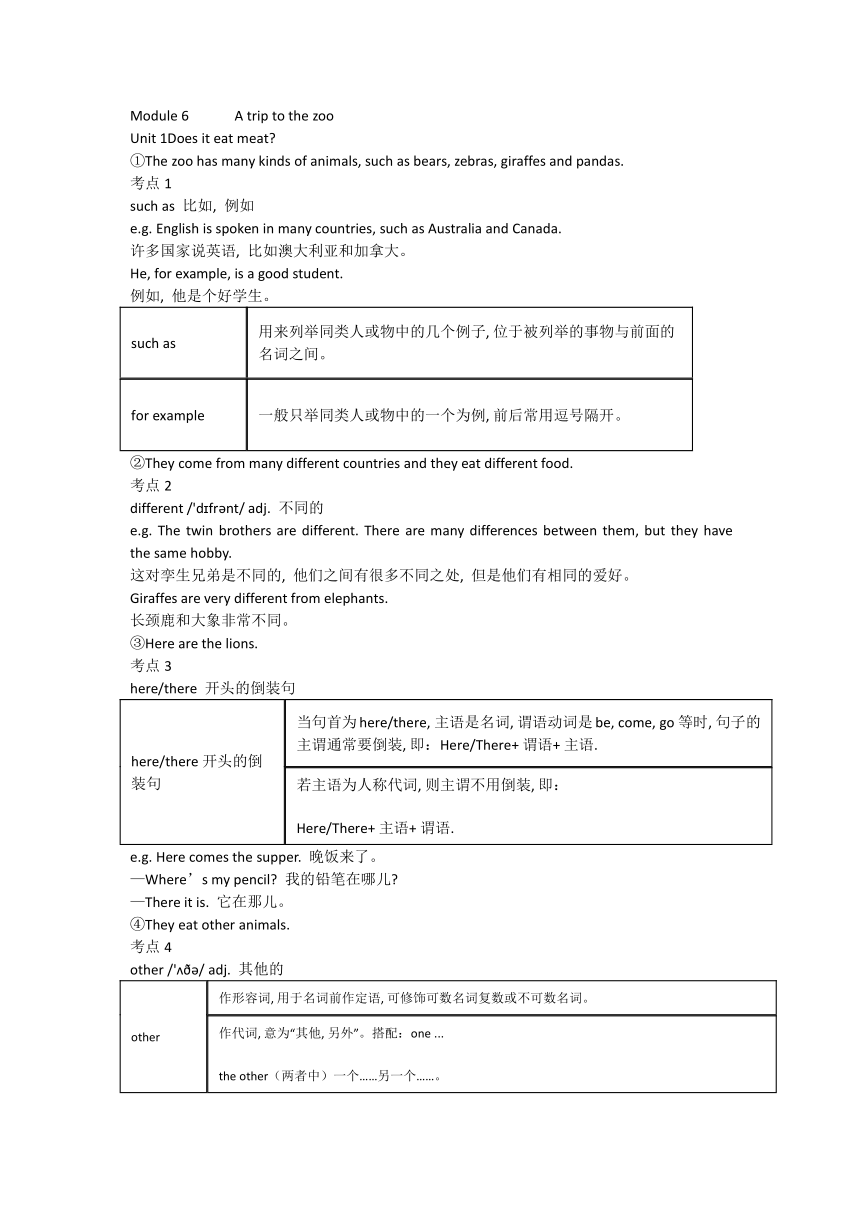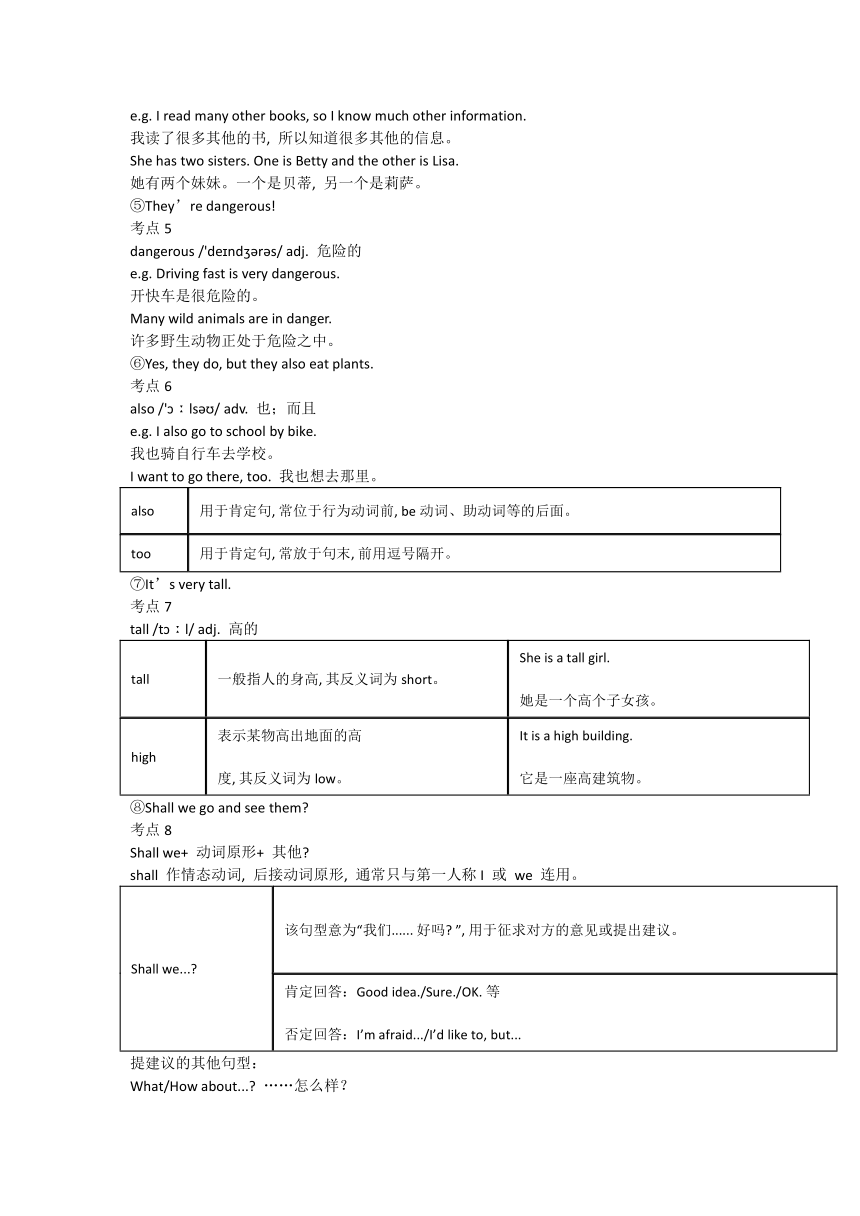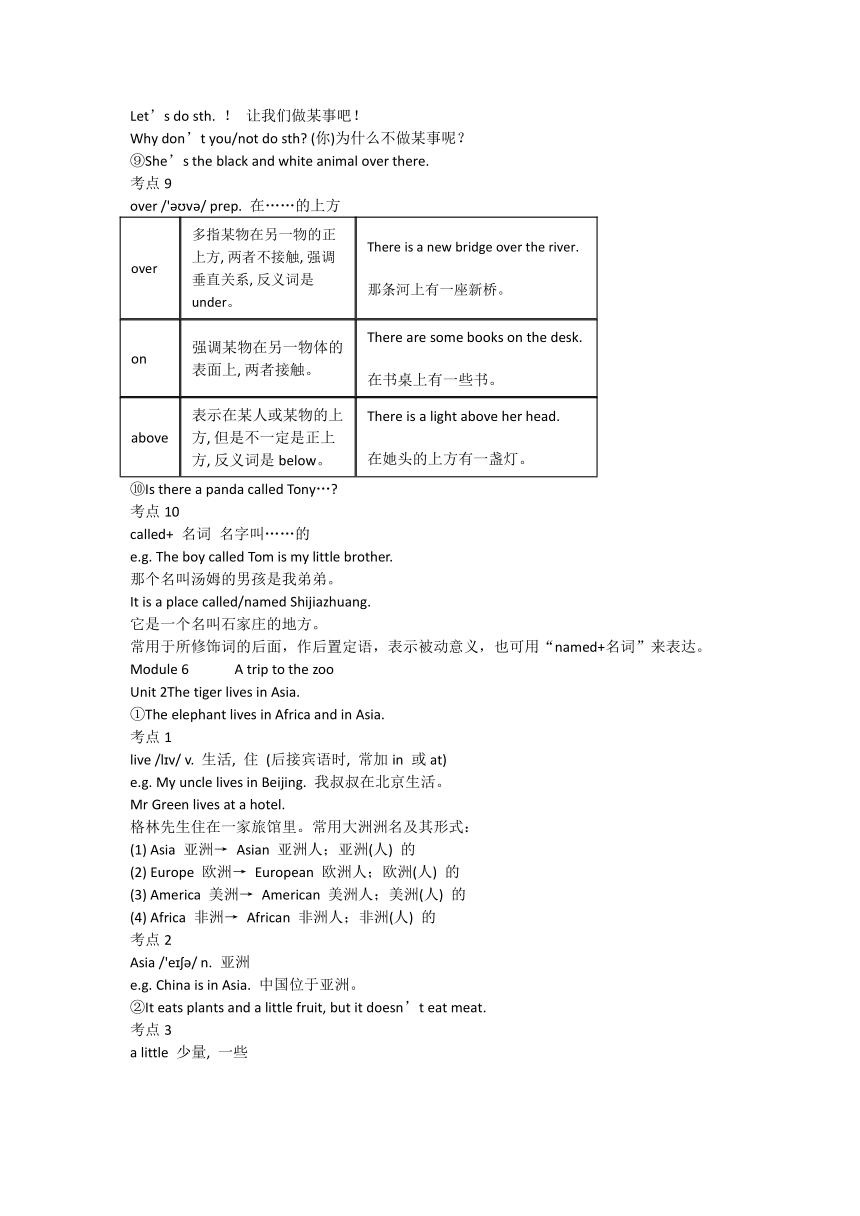Module 6 A trip to the zoo 复习讲义 外研版英语七年级上册
文档属性
| 名称 | Module 6 A trip to the zoo 复习讲义 外研版英语七年级上册 |  | |
| 格式 | docx | ||
| 文件大小 | 129.6KB | ||
| 资源类型 | 教案 | ||
| 版本资源 | 外研版 | ||
| 科目 | 英语 | ||
| 更新时间 | 2023-09-06 07:25:15 | ||
图片预览



文档简介
Module 6 A trip to the zoo
Unit 1Does it eat meat
①The zoo has many kinds of animals, such as bears, zebras, giraffes and pandas.
考点1
such as 比如, 例如
e.g. English is spoken in many countries, such as Australia and Canada.
许多国家说英语, 比如澳大利亚和加拿大。
He, for example, is a good student.
例如, 他是个好学生。
such as 用来列举同类人或物中的几个例子, 位于被列举的事物与前面的名词之间。
for example 一般只举同类人或物中的一个为例, 前后常用逗号隔开。
②They come from many different countries and they eat different food.
考点2
different /'d fr nt/ adj. 不同的
e.g. The twin brothers are different. There are many differences between them, but they have the same hobby.
这对孪生兄弟是不同的, 他们之间有很多不同之处, 但是他们有相同的爱好。
Giraffes are very different from elephants.
长颈鹿和大象非常不同。
③Here are the lions.
考点3
here/there 开头的倒装句
here/there 开头的倒装句 当句首为here/there, 主语是名词, 谓语动词是be, come, go 等时, 句子的主谓通常要倒装, 即:Here/There+ 谓语+ 主语.
若主语为人称代词, 则主谓不用倒装, 即: Here/There+ 主语+ 谓语.
e.g. Here comes the supper. 晚饭来了。
—Where’s my pencil 我的铅笔在哪儿
—There it is. 它在那儿。
④They eat other animals.
考点4
other /' / adj. 其他的
other 作形容词, 用于名词前作定语, 可修饰可数名词复数或不可数名词。
作代词, 意为“其他, 另外”。搭配:one ... the other(两者中)一个……另一个……。
e.g. I read many other books, so I know much other information.
我读了很多其他的书, 所以知道很多其他的信息。
She has two sisters. One is Betty and the other is Lisa.
她有两个妹妹。一个是贝蒂, 另一个是莉萨。
⑤They’re dangerous!
考点5
dangerous /'de nd r s/ adj. 危险的
e.g. Driving fast is very dangerous.
开快车是很危险的。
Many wild animals are in danger.
许多野生动物正处于危险之中。
⑥Yes, they do, but they also eat plants.
考点6
also /' ls / adv. 也;而且
e.g. I also go to school by bike.
我也骑自行车去学校。
I want to go there, too. 我也想去那里。
also 用于肯定句, 常位于行为动词前, be动词、助动词等的后面。
too 用于肯定句, 常放于句末, 前用逗号隔开。
⑦It’s very tall.
考点7
tall /t l/ adj. 高的
tall 一般指人的身高, 其反义词为short。 She is a tall girl. 她是一个高个子女孩。
high 表示某物高出地面的高 度, 其反义词为low。 It is a high building. 它是一座高建筑物。
⑧Shall we go and see them
考点8
Shall we+ 动词原形+ 其他
shall 作情态动词, 后接动词原形, 通常只与第一人称I 或 we 连用。
Shall we... 该句型意为“我们...... 好吗 ”, 用于征求对方的意见或提出建议。
肯定回答:Good idea./Sure./OK. 等 否定回答:I’m afraid.../I’d like to, but...
提建议的其他句型:
What/How about... ……怎么样?
Let’s do sth. ! 让我们做某事吧!
Why don’t you/not do sth (你)为什么不做某事呢?
⑨She’s the black and white animal over there.
考点9
over /' v / prep. 在……的上方
over 多指某物在另一物的正上方, 两者不接触, 强调垂直关系, 反义词是under。 There is a new bridge over the river. 那条河上有一座新桥。
on 强调某物在另一物体的表面上, 两者接触。 There are some books on the desk. 在书桌上有一些书。
above 表示在某人或某物的上方, 但是不一定是正上方, 反义词是below。 There is a light above her head. 在她头的上方有一盏灯。
⑩Is there a panda called Tony…
考点10
called+ 名词 名字叫……的
e.g. The boy called Tom is my little brother.
那个名叫汤姆的男孩是我弟弟。
It is a place called/named Shijiazhuang.
它是一个名叫石家庄的地方。
常用于所修饰词的后面,作后置定语,表示被动意义,也可用“named+名词”来表达。
Module 6 A trip to the zoo
Unit 2The tiger lives in Asia.
①The elephant lives in Africa and in Asia.
考点1
live /l v/ v. 生活, 住 (后接宾语时, 常加in 或at)
e.g. My uncle lives in Beijing. 我叔叔在北京生活。
Mr Green lives at a hotel.
格林先生住在一家旅馆里。常用大洲洲名及其形式:
(1) Asia 亚洲→ Asian 亚洲人;亚洲(人) 的
(2) Europe 欧洲→ European 欧洲人;欧洲(人) 的
(3) America 美洲→ American 美洲人;美洲(人) 的
(4) Africa 非洲→ African 非洲人;非洲(人) 的
考点2
Asia /'e / n. 亚洲
e.g. China is in Asia. 中国位于亚洲。
②It eats plants and a little fruit, but it doesn’t eat meat.
考点3
a little 少量, 一些
little “极少量的”, 表示否定意义。 两者均修饰 不可数名词 We have little milk in the fridge, but a little juice. 我们的冰箱里几乎没有牛奶了, 但是有一点果汁。
a little “少量”, 表 示肯定意义。
③The panda eats about 30 kilos of bamboo a day as well as other plants.
考点4
as well as 并且, 还
e.g. Tom as well as his parents is here.
汤姆和他的父母在这儿。
I as well as Tom am ready to help you.
不仅汤姆愿意帮助你, 而且我也愿意帮助你。
④This black and white animal is the favourite of people all over the world.
考点5
people /'pi pl/ n. 人们, 人
people 前不加定冠词the 时, 泛指人们, 为集合名词, 作主语时, 谓语动词用复数, 用在数词等修饰词后面不用再加s。
e.g. There were a lot of people at the party.
有许多人参加聚会。
⑤It eats leaves as well as grass, but the zebra doesn’t eat bamboo.
考点6
leaf /li f/ n. 叶子
leaf 的复数形式是leaves; leaves 还可作为动词leave的第三人称单数形式, 需根据语境判断其意思。
e.g. It is autumn and the leaves are yellow.
秋天到了, 叶子黄了。
⑥It’s a very large animal and usually lives alone.
考点7
large /lɑ d / adj. 巨大的, 大的
large 常指面积或者范围, 可表示数和量(一般不用来修饰人, 但可以形容四肢), 反义词是small。
big 常指程度、范围、规模、容积、重量、数量等(还可以表示“伟大, 重要”之意), 常可与large 互换, 多用于具体的、有形的人或物, 反义词是little/small。
e.g. China is a large country. 中国是个大国。
There is a big tree beside the house.
那个房子旁边有一棵大树。
考点8
alone / 'l n/ adv. 独自地
lonely 形容词, “孤单的;寂寞的”, 指主观上感到孤独, 寂寞, 有强烈的感彩, 因缺乏朋友、同情等而产生一种悲伤或忧郁的感情。lonely 在句中可作表语和定语。
alone 副词, 意思是“独自地;单独地”, 只表示数量上的单一。
形容词, “独自的;单独的”, 只能作表语, 不能作定语。
e.g. He often feels lonely. 他经常感到孤独。
The old man lives alone. 那个老人独自生活。
He is alone in the room. 他一个人在房间里。
⑦It likes water and is good at swimming.
考点9
be good at 擅长
e.g. I am good at writing.(=I do well in writing.)
我擅长写作。
⑧It’s strong and catches many kinds of animals for food.
考点10
catch /k t / v. 抓住;接住
e.g. The cat is catching fish. 那只猫正在捉鱼。
Catch the ball! 接球!
拓展:catch 还可表示“跟上, 赶上”。
e.g. catch the early bus 赶上早班公共汽车
Unit 3Language in use
①Look at this one.
考点1
one /w n/ pron. 一个
e.g. My bike is old. I want to buy another one.
我的自行车旧了。我想再买一辆。
辨析:one 与it
one指代前面提到的那一类中的一个,若代替复数名词,则用ones。
it特指前面提到的那一个。
②With its strong tail and back legs, the kangaroo jumps across the grassland.
考点2
with /w / prep. 用
e.g. He writes with a pen. 他用钢笔写字。
What’s this in English 这个用英语怎么说?
辨析: with 与in
with 表示用……工具(具体的工具)。
in 表示用……材料;以……方式;用……语言。
考点3
across / kr s/ prep. 穿过;横过
across 作介词, 意为“穿过;横过”, 侧重指从物体的表面通过, 从一边到另一边。 We are walking across the road. 我们正在穿过马路。
over 作介词, 意为“越过; 在……上方”。 He jumps over the fence. 他跳过篱笆。
through 作介词, 意为“穿过”, 指从物体内部穿过。 We will walk through the forest. 我们将徒步穿过森林。
行为动词的一般现在时(2)
考点
当主语是第三人称单数时, 行为动词的词尾要加s 或es, 即用第三人称单数形式。其结构为“主语 (He, She, It) +动词第三人称单数形式+其他.”。
e.g. He goes to school on foot. 他步行去学校。
考向1
行为动词一般现在时的第三人称单数形式的构成方法如下表所示。
一般的动词在动词原形后加s work—works live—lives
以s, x, sh, ch 结尾的动词加es finish—finishes teach—teaches guess—guesses fix—fixes
以辅音字母加y 结尾的动词变y 为i 再加es carry—carries fly—flies
以元音字母加y 结尾的动词直接加s play—plays
以辅音字母加o 结尾的动词一般在词尾加es go—goes do—does
考向2
主语是第三人称单数时, 句式变化如下:
Unit 1Does it eat meat
①The zoo has many kinds of animals, such as bears, zebras, giraffes and pandas.
考点1
such as 比如, 例如
e.g. English is spoken in many countries, such as Australia and Canada.
许多国家说英语, 比如澳大利亚和加拿大。
He, for example, is a good student.
例如, 他是个好学生。
such as 用来列举同类人或物中的几个例子, 位于被列举的事物与前面的名词之间。
for example 一般只举同类人或物中的一个为例, 前后常用逗号隔开。
②They come from many different countries and they eat different food.
考点2
different /'d fr nt/ adj. 不同的
e.g. The twin brothers are different. There are many differences between them, but they have the same hobby.
这对孪生兄弟是不同的, 他们之间有很多不同之处, 但是他们有相同的爱好。
Giraffes are very different from elephants.
长颈鹿和大象非常不同。
③Here are the lions.
考点3
here/there 开头的倒装句
here/there 开头的倒装句 当句首为here/there, 主语是名词, 谓语动词是be, come, go 等时, 句子的主谓通常要倒装, 即:Here/There+ 谓语+ 主语.
若主语为人称代词, 则主谓不用倒装, 即: Here/There+ 主语+ 谓语.
e.g. Here comes the supper. 晚饭来了。
—Where’s my pencil 我的铅笔在哪儿
—There it is. 它在那儿。
④They eat other animals.
考点4
other /' / adj. 其他的
other 作形容词, 用于名词前作定语, 可修饰可数名词复数或不可数名词。
作代词, 意为“其他, 另外”。搭配:one ... the other(两者中)一个……另一个……。
e.g. I read many other books, so I know much other information.
我读了很多其他的书, 所以知道很多其他的信息。
She has two sisters. One is Betty and the other is Lisa.
她有两个妹妹。一个是贝蒂, 另一个是莉萨。
⑤They’re dangerous!
考点5
dangerous /'de nd r s/ adj. 危险的
e.g. Driving fast is very dangerous.
开快车是很危险的。
Many wild animals are in danger.
许多野生动物正处于危险之中。
⑥Yes, they do, but they also eat plants.
考点6
also /' ls / adv. 也;而且
e.g. I also go to school by bike.
我也骑自行车去学校。
I want to go there, too. 我也想去那里。
also 用于肯定句, 常位于行为动词前, be动词、助动词等的后面。
too 用于肯定句, 常放于句末, 前用逗号隔开。
⑦It’s very tall.
考点7
tall /t l/ adj. 高的
tall 一般指人的身高, 其反义词为short。 She is a tall girl. 她是一个高个子女孩。
high 表示某物高出地面的高 度, 其反义词为low。 It is a high building. 它是一座高建筑物。
⑧Shall we go and see them
考点8
Shall we+ 动词原形+ 其他
shall 作情态动词, 后接动词原形, 通常只与第一人称I 或 we 连用。
Shall we... 该句型意为“我们...... 好吗 ”, 用于征求对方的意见或提出建议。
肯定回答:Good idea./Sure./OK. 等 否定回答:I’m afraid.../I’d like to, but...
提建议的其他句型:
What/How about... ……怎么样?
Let’s do sth. ! 让我们做某事吧!
Why don’t you/not do sth (你)为什么不做某事呢?
⑨She’s the black and white animal over there.
考点9
over /' v / prep. 在……的上方
over 多指某物在另一物的正上方, 两者不接触, 强调垂直关系, 反义词是under。 There is a new bridge over the river. 那条河上有一座新桥。
on 强调某物在另一物体的表面上, 两者接触。 There are some books on the desk. 在书桌上有一些书。
above 表示在某人或某物的上方, 但是不一定是正上方, 反义词是below。 There is a light above her head. 在她头的上方有一盏灯。
⑩Is there a panda called Tony…
考点10
called+ 名词 名字叫……的
e.g. The boy called Tom is my little brother.
那个名叫汤姆的男孩是我弟弟。
It is a place called/named Shijiazhuang.
它是一个名叫石家庄的地方。
常用于所修饰词的后面,作后置定语,表示被动意义,也可用“named+名词”来表达。
Module 6 A trip to the zoo
Unit 2The tiger lives in Asia.
①The elephant lives in Africa and in Asia.
考点1
live /l v/ v. 生活, 住 (后接宾语时, 常加in 或at)
e.g. My uncle lives in Beijing. 我叔叔在北京生活。
Mr Green lives at a hotel.
格林先生住在一家旅馆里。常用大洲洲名及其形式:
(1) Asia 亚洲→ Asian 亚洲人;亚洲(人) 的
(2) Europe 欧洲→ European 欧洲人;欧洲(人) 的
(3) America 美洲→ American 美洲人;美洲(人) 的
(4) Africa 非洲→ African 非洲人;非洲(人) 的
考点2
Asia /'e / n. 亚洲
e.g. China is in Asia. 中国位于亚洲。
②It eats plants and a little fruit, but it doesn’t eat meat.
考点3
a little 少量, 一些
little “极少量的”, 表示否定意义。 两者均修饰 不可数名词 We have little milk in the fridge, but a little juice. 我们的冰箱里几乎没有牛奶了, 但是有一点果汁。
a little “少量”, 表 示肯定意义。
③The panda eats about 30 kilos of bamboo a day as well as other plants.
考点4
as well as 并且, 还
e.g. Tom as well as his parents is here.
汤姆和他的父母在这儿。
I as well as Tom am ready to help you.
不仅汤姆愿意帮助你, 而且我也愿意帮助你。
④This black and white animal is the favourite of people all over the world.
考点5
people /'pi pl/ n. 人们, 人
people 前不加定冠词the 时, 泛指人们, 为集合名词, 作主语时, 谓语动词用复数, 用在数词等修饰词后面不用再加s。
e.g. There were a lot of people at the party.
有许多人参加聚会。
⑤It eats leaves as well as grass, but the zebra doesn’t eat bamboo.
考点6
leaf /li f/ n. 叶子
leaf 的复数形式是leaves; leaves 还可作为动词leave的第三人称单数形式, 需根据语境判断其意思。
e.g. It is autumn and the leaves are yellow.
秋天到了, 叶子黄了。
⑥It’s a very large animal and usually lives alone.
考点7
large /lɑ d / adj. 巨大的, 大的
large 常指面积或者范围, 可表示数和量(一般不用来修饰人, 但可以形容四肢), 反义词是small。
big 常指程度、范围、规模、容积、重量、数量等(还可以表示“伟大, 重要”之意), 常可与large 互换, 多用于具体的、有形的人或物, 反义词是little/small。
e.g. China is a large country. 中国是个大国。
There is a big tree beside the house.
那个房子旁边有一棵大树。
考点8
alone / 'l n/ adv. 独自地
lonely 形容词, “孤单的;寂寞的”, 指主观上感到孤独, 寂寞, 有强烈的感彩, 因缺乏朋友、同情等而产生一种悲伤或忧郁的感情。lonely 在句中可作表语和定语。
alone 副词, 意思是“独自地;单独地”, 只表示数量上的单一。
形容词, “独自的;单独的”, 只能作表语, 不能作定语。
e.g. He often feels lonely. 他经常感到孤独。
The old man lives alone. 那个老人独自生活。
He is alone in the room. 他一个人在房间里。
⑦It likes water and is good at swimming.
考点9
be good at 擅长
e.g. I am good at writing.(=I do well in writing.)
我擅长写作。
⑧It’s strong and catches many kinds of animals for food.
考点10
catch /k t / v. 抓住;接住
e.g. The cat is catching fish. 那只猫正在捉鱼。
Catch the ball! 接球!
拓展:catch 还可表示“跟上, 赶上”。
e.g. catch the early bus 赶上早班公共汽车
Unit 3Language in use
①Look at this one.
考点1
one /w n/ pron. 一个
e.g. My bike is old. I want to buy another one.
我的自行车旧了。我想再买一辆。
辨析:one 与it
one指代前面提到的那一类中的一个,若代替复数名词,则用ones。
it特指前面提到的那一个。
②With its strong tail and back legs, the kangaroo jumps across the grassland.
考点2
with /w / prep. 用
e.g. He writes with a pen. 他用钢笔写字。
What’s this in English 这个用英语怎么说?
辨析: with 与in
with 表示用……工具(具体的工具)。
in 表示用……材料;以……方式;用……语言。
考点3
across / kr s/ prep. 穿过;横过
across 作介词, 意为“穿过;横过”, 侧重指从物体的表面通过, 从一边到另一边。 We are walking across the road. 我们正在穿过马路。
over 作介词, 意为“越过; 在……上方”。 He jumps over the fence. 他跳过篱笆。
through 作介词, 意为“穿过”, 指从物体内部穿过。 We will walk through the forest. 我们将徒步穿过森林。
行为动词的一般现在时(2)
考点
当主语是第三人称单数时, 行为动词的词尾要加s 或es, 即用第三人称单数形式。其结构为“主语 (He, She, It) +动词第三人称单数形式+其他.”。
e.g. He goes to school on foot. 他步行去学校。
考向1
行为动词一般现在时的第三人称单数形式的构成方法如下表所示。
一般的动词在动词原形后加s work—works live—lives
以s, x, sh, ch 结尾的动词加es finish—finishes teach—teaches guess—guesses fix—fixes
以辅音字母加y 结尾的动词变y 为i 再加es carry—carries fly—flies
以元音字母加y 结尾的动词直接加s play—plays
以辅音字母加o 结尾的动词一般在词尾加es go—goes do—does
考向2
主语是第三人称单数时, 句式变化如下:
同课章节目录
- Starte
- Module 1 My teacher and my friends
- Module 2 My English lesson
- Module 3 My English book
- Module 4 My everyday life
- Module 1 My classmates
- Unit 1 Nice to meet you.
- Unit 2 I'm Wang Lingling and I'm thirteen years ol
- Unit 3 Language in use.
- Module 2 My family
- Unit 1 Is this your mum?
- Unit 2 These are my parents.
- Unit 3 Language in use.
- Module 3 My school
- Unit 1 There are thirty students in my class.
- Unit 2 The library is on the left of the playgroun
- Unit 3 Language in use.
- Module 4 Healthy food
- Unit 1 We've got lots of apples.
- Unit 2 Is your food and drink healthy?
- Unit 3 Language in use.
- Module 5 My school day
- Unit 1 I love history.
- Unit 2 We start work at nine o'clock.
- Unit 3 Language in use.
- Revision module A
- Module 6 A trip to the zoo
- Unit 1 Does it eat meat?
- Unit 2 The tiger lives in Asia.
- Unit 3 Language in use.
- Module 7 Computers
- Unit 1 How do I write my homework on the computer?
- Unit 2 When do you use a computer?
- Unit 3 Language in use.
- Module 8 Choosing presents
- Unit 1 I always like birthday parties.
- Unit 2 She often goes to concerts.
- Unit 3 Language in use.
- Module 9 People and places
- Unit 1 We're enjoying the school trip a lot.
- Unit 2 They're waiting for buses or trains.
- Unit 3 Language in use.
- Module 10 Spring Festival
- Unit 1 Are you getting ready for Spring Festival?
- Unit 2 My mother's cleaning our houses and sweepin
- Unit 3 Language in use.
- Revision module B
